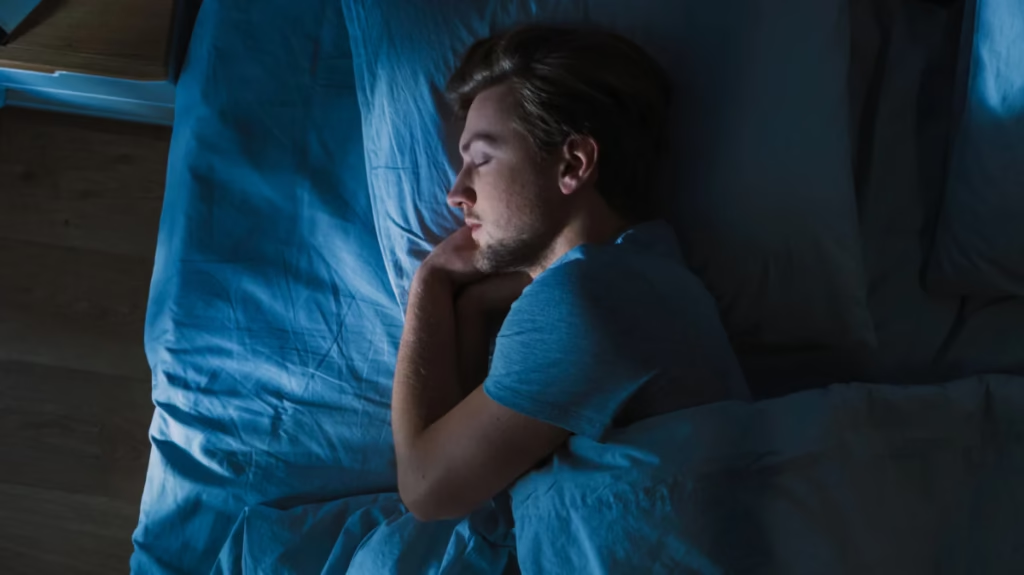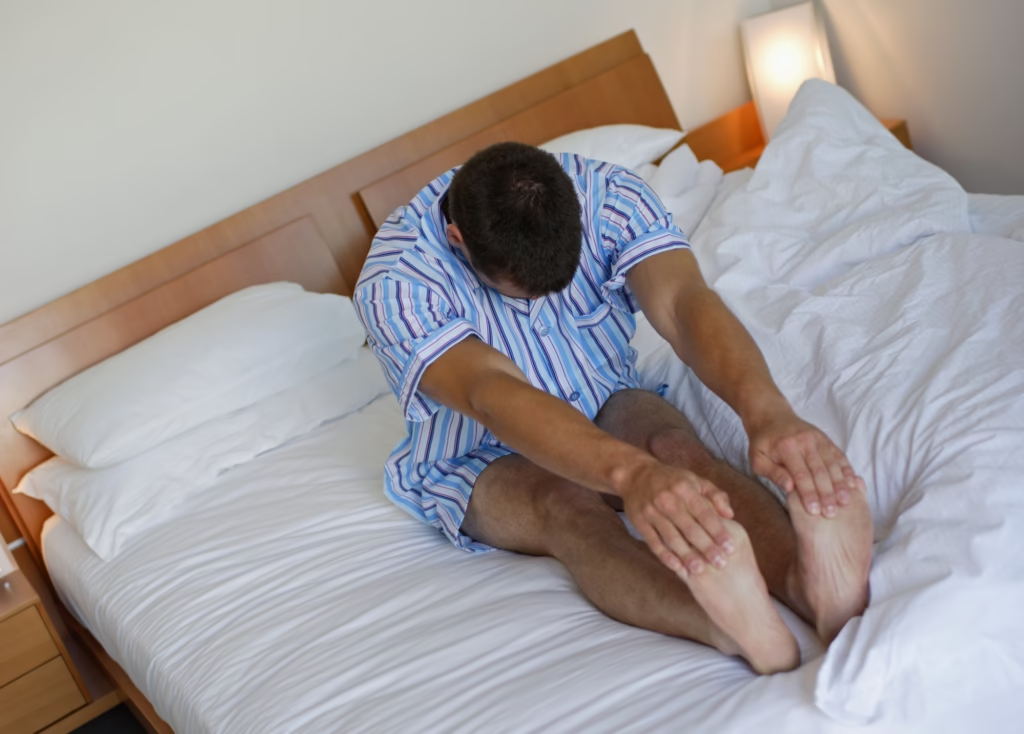Better sleep does more than help mood. It speeds up muscle repair, reduces soreness, and boosts training gains. This guide explains the science behind sleep for muscle recovery, then turns it into simple habits anyone can use tonight.
Here is the plan. First, how sleep stages, hormones, and the body clock drive repair. Then, practical steps, from deep sleep targets to wind-down routines, timing of training, smart nutrition, and light control. The tone stays friendly, the tips stay simple, and the science stays solid.
Expect a focus on deep sleep, circadian rhythm, relaxation techniques, smart timing, and easy-to-use tech. Small changes add up fast when they target the right biology.
How sleep repairs muscle: simple science that matters for gains
Training creates small tears in muscle fibres. Recovery rebuilds them stronger. Sleep is the body’s prime repair window, where hormones surge, inflammation settles, and the nervous system resets.
Sleep cycles through stages: light NREM, deep NREM, and REM. Two stages matter most for training outcomes:
- Deep sleep, also called slow wave sleep or SWS, drives tissue repair and immune restoration.
- REM sleep supports the brain, motor learning, pain processing, and mood.
Think of deep sleep as the building crew, and REM as the project manager that files plans, updates patterns, and keeps motivation steady.
Deep sleep (SWS) triggers growth hormone and tissue repair
During deep sleep, the brain releases pulses of growth hormone. This hormone supports protein synthesis and helps muscle recovery and repair fibres after hard work. Research shows that growth hormone peaks during slow-wave sleep, which is why deep sleep minutes matter for muscle recovery. See the review on the relationship between growth hormone and sleep.
A useful benchmark is at least 90 minutes of deep sleep most nights. More is not always better, but consistently hitting this mark supports repair.
Deep sleep also helps the immune system. It balances inflammation and supports white blood cell function, both key after intense sessions that cause micro-damage.
REM sleep resets the brain, supports motor learning, and reduces pain
REM sleep helps the brain consolidate movement patterns learned during training. This supports skill work, form, and timing. REM also links to pain modulation and mood. Better REM often means steadier motivation and a higher tolerance for soreness, so sessions feel more manageable.
Sleep debt blunts strength, increases inflammation, and slows recovery..
Short sleep reduces power and slows reaction time. It also raises stress hormones and inflammatory markers, which can make muscles feel stiff and sore for longer. One controlled study found that acute sleep loss can reduce muscle protein synthesis and push hormones in a catabolic direction. The paper on acute sleep deprivation and skeletal muscle lays out these effects in healthy adults.
Poor sleep usually cuts time spent in deep sleep, which reduces growth hormone release that helps muscle recovery. That delay in repair shows up as longer-lasting soreness, lower force output, and patchy training quality.
How much sleep do active people need to recover well?
Most adults do best with 7 to 9 hours. Many athletes feel sharper with 8 to 10. Quality counts as much as quantity. The body likes regularity: consistent sleep and wake times improve deep sleep and steady recovery.
For a clear overview of training and sleep needs, the Sleep Foundation summarises sleep, athletic performance, and recovery in plain terms.
Night routine and bedroom hacks to gain more deep sleep
Aim for habits that nudge the body clock, calm the nervous system, and make the bedroom a predictable signal for sleep. Here is a practical set of steps to try tonight.
Set a fixed sleep window and a calm wind-down to sync the body clock
The body clock likes rhythms. Pick a fixed sleep window, for example, 11 pm to 7 am, and stick to it daily where possible. A set wake time helps deepen sleep pressure and stabilizes hormone timing.
Add a 30 to 60 minute wind-down with the same sequence each night. Keep it simple:
- Light stretching, the hips and the thoracic spine are good targets.
- A warm shower to relax muscles.
- Quiet reading or gentle music with low light.
That sequence trains the brain to recognize that sleep is coming.
Relaxation that works: progressive muscle relaxation and slow nasal breathing
Progressive muscle relaxation reduces tension and speeds sleep onset. Start at the feet, tense for 5 seconds, then release for 10. Move to calves, thighs, glutes, abs, hands, forearms, shoulders, neck, then face. Keep the effort gentle.
Pair this with slow nasal breathing. Try 4 seconds in, 6 seconds out, for 3 to 5 minutes. This pace activates the parasympathetic system, which lowers heart rate and primes deep sleep.
Control light, noise, and temperature for deeper sleep
Light is a strong signal. Use dim, warm light in the last hour. Limit screens or use the warmest, dimmest settings. Blackout curtains or an eye mask help keep the room dark. If noise is an issue, try earplugs or a simple sound machine.
Keep the bedroom cool and choose breathable bedding. Cooler air helps the body drop core temperature, which improves deep sleep and reduces wake-ups. For more ideas on room setup and rhythms, TrainingPeaks outlines five strategies for better sleep.
Smart evening nutrition: casein protein, magnesium, and careful caffeine and alcohol
A light, protein-rich snack 1 to 2 hours before bed can support overnight repair without heavy digestion. Greek yogurt, cottage cheese, or a small casein shake works well. Avoid large meals late at night, which can disrupt sleep.
Some people do well with magnesium glycinate, about an hour before bed. Tart cherries can help with soreness for some, taken in the early evening.
Caffeine has a long tail. Set a cut-off in the early afternoon to protect deep sleep. Alcohol can reduce deep sleep and fragment the night, so keep it light and avoid it close to bedtime.
Daytime habits and training timing that boost muscle recovery and sleep
Strong nights start with smart days. The body clock needs light, movement, and temperature cues. Training timing also plays a part.
Train at the right time to sleep better and heal faster
Hard sessions earlier in the day tend to suit deep sleep better. Very late intense workouts can raise core temperature and adrenaline, which can delay sleep. A simple rule helps: finish hard training at least 3 hours before bed. Easy mobility work, breathwork, or a short walk are fine later in the evening.
Morning light, daytime movement, and less late blue light
Get morning daylight within an hour of waking if possible. A short walk, even on a cloudy day, sets the circadian clock. Move regularly during the day. If sitting for long periods, take 2-minute breaks every hour.
In the last hour before bed, reduce bright screens or set devices to warm and dim settings. Keep room lights low, ideally warm white bulbs.
For a broad view of how circadian biology interacts with muscle, see this review on sleep, circadian biology, and skeletal muscle.
Heat and cold timing: soothe muscles without hurting sleep
Use heat or sauna earlier in the evening to relax muscles and joints. Avoid very hot sessions right before bed if they leave the body overheated.
Cold exposure can feel alerting for some. If using ice baths or cold showers, try them earlier in the day or straight after training, not close to bedtime. Let comfort lead. The goal is recovery, not extremes.
Naps and catch-up sleep: when and how to use them
Short naps help when sleep is short. Aim for 10 to 20 minutes, early to mid-afternoon. Avoid late naps that push bedtime.
Regular nights beat heavy weekend catch-up. If needing extra sleep, add 30 to 60 minutes for a few nights, rather than a single long lie-in.
For patterns used by athletes, see the review on sleep and muscle recovery practices of athletes.
Track, test, and adjust: wearables, simple logs, and proven tools
Tracking helps confirm what works. Keep it light and focused. Look for trends, not perfection.
What to track: deep sleep minutes, HRV, resting heart rate, and time to fall asleep
Useful metrics:
- Deep sleep minutes
- Total time asleep
- Resting heart rate
- Heart rate variability, or HRV
- Sleep latency, time to fall asleep
What better looks like over the weeks:
- More consistent deep sleep minutes
- Fewer wake-ups
- Lower resting heart rate on recovery days
- HRV that stays steady or climbs slightly
- Shorter time to fall asleep
- Steadier morning energy and mood
A simple table can help keep eyes on the right targets.
| Metric | What to Watch | Better Over Weeks |
|---|---|---|
| Deep sleep minutes | Aim for 90+ most nights | More consistent, fewer dips |
| Total sleep | 7 to 9 hours, athletes 8 to 10 | Stable window, not big weekday swings |
| Resting heart rate | Baseline over a quiet week | Slightly lower on easy days |
| HRV | Personal baseline | Stable or trending up |
| Sleep latency | Under 20 minutes | Faster onset with wind-down routine |
Make wearables useful: Oura Ring, Garmin, Apple Watch, and simple apps
Wearables are tools, not judges. Use them to spot patterns, not to chase perfect scores. Pair device data with a 1-minute note each morning, rating soreness, energy, and mood on a simple 1 to 5 scale.
Try small experiments for 1 to 2 weeks:
- Move hard training earlier by 2 hours.
- Add progressive muscle relaxation at lights out.
- Shift caffeine cut-off to 1 pm.
- Darken the room with an eye mask.
Watch trends across several nights, not single days. For a consumer-friendly overview, this guide on how sleep helps muscle recovery and growth highlights the link between deep sleep and repair.
If sleep still struggles: try behavioural sleep medicine basics
If nights stay patchy, use a few simple rules from behavioural sleep medicine:
- Fix the wake time, even after a poor night.
- Use a consistent sleep window, slightly shorter if time in bed is very fragmented.
- If unable to sleep after about 20 minutes, get out of bed. Sit somewhere dim and quiet, read a calming book, then return when sleepy.
- Keep the bed for sleep and intimacy. Avoid scrolling or working in bed.
Consistency teaches the brain that bed equals sleep.
A simple 7-day muscle recovery sleep plan to test
Test this plan for one week and watch deep sleep minutes, HRV, and morning energy.
- Day 1: Set a fixed sleep window and wake time. Pick a realistic 8-hour window.
- Day 2: Add progressive muscle relaxation at lights out. 5 minutes is enough.
- Day 3, Move caffeine cut-off to early afternoon. Swap late coffee for herbal tea.
- Day 4: Darken the room. Use blackout curtains or an eye mask.
- Day 5, Move hard training earlier. Finish intense work at least 3 hours before bed.
- Day 6, Track light exposure. Get morning daylight and keep late evening lights dim and warm.
- Day 7, Review data. Check deep sleep minutes, sleep latency, and how sore or fresh the body feels. Keep what worked, adjust one thing that did not.
For a broader context on athlete routines and environment tweaks, the Sleep Foundation’s guide on athletic performance and sleep and the research on sleep practices in athletes provide helpful checklists and patterns to copy.
Conclusion
Deep sleep and the circadian rhythm drive muscle repair. Keep a fixed sleep window, practise progressive muscle relaxation, control light, noise, and temperature, time training and caffeine well, and track simple metrics like deep sleep minutes and HRV. Small, steady steps beat perfect plans.
Set the sleep window tonight, then try a 5-minute PMR drill at lights out. Keep notes for a week, look for trends, and keep what works. Gains follow recovery, and recovery follows great sleep.
Related Health News:
Skinny Fat Transformation Real Meal Plans (Non-Bodybuilder Version)


















